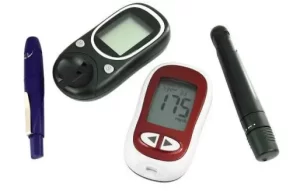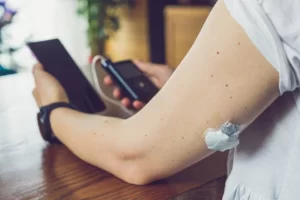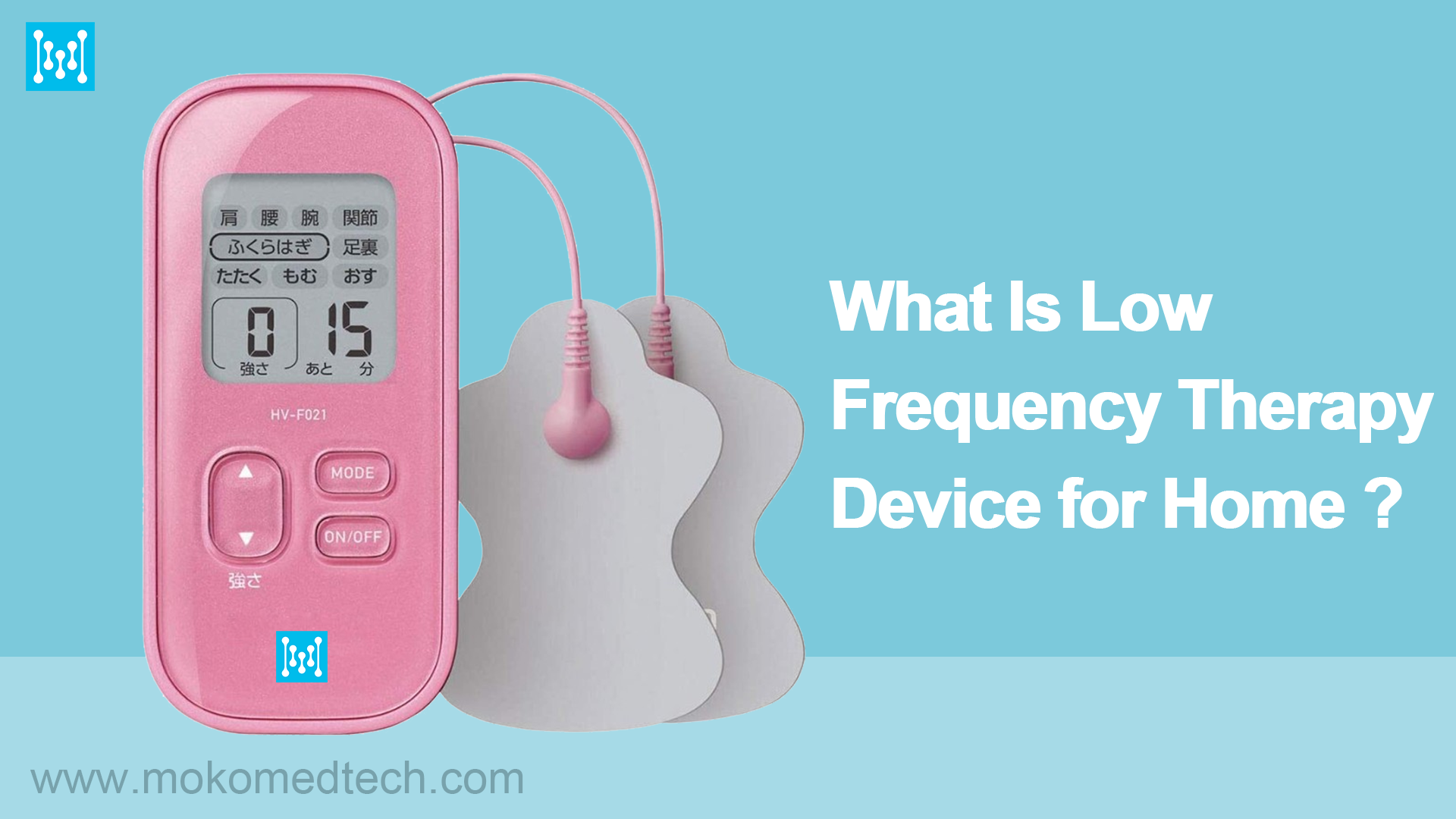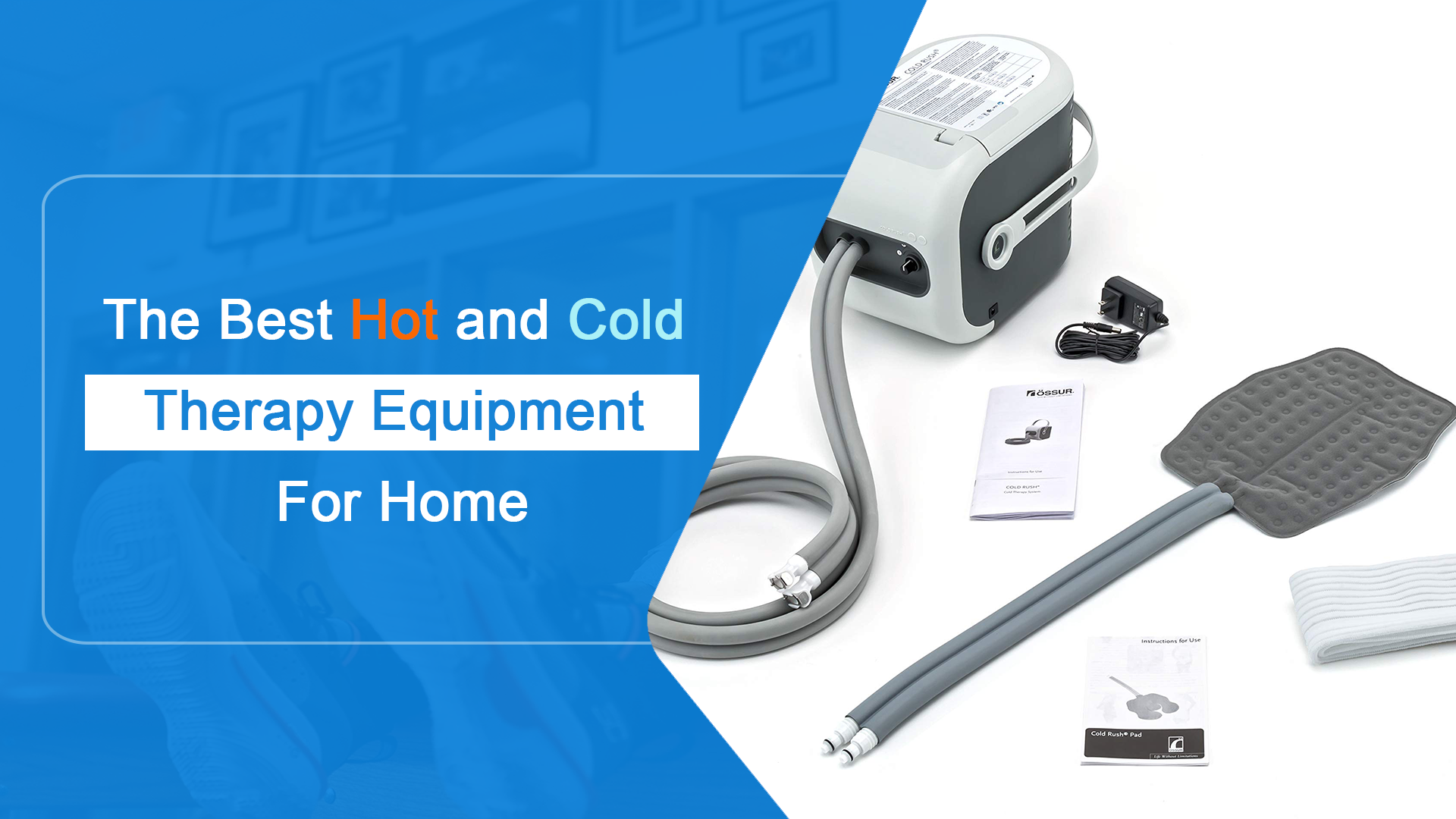There are various types of blood sugar monitoring for people with diabetes. Certain devices necessitate regular finger pricking, while others solely require such pricking once for calibration. These monitors gauge an individual’s blood sugar levels, aiding physicians in assessing the necessity for additional medical intervention. This article will discuss different types of blood sugar monitoring that do not require finger pricks and the comparisons. It also will introduce some famous brands or devices and their cost.
Types of Blood Sugar Monitoring without Finger Pricks?
Several alternatives to traditional finger-prick blood sugar monitoring are available for individuals with diabetes. These three options are continuous glucose monitors, breath tests, and earlobe tests.

Continuous Glucose Monitors (CGMs)
CGMs are automated systems that monitor blood sugar levels at regular intervals. Users are spared the need for finger pricks, although occasional calibration with finger-prick measurements might be necessary for accuracy.
A previous study found that CGM sensors can be placed under the skin in areas like the abdomen, buttocks, thighs, or upper arm. These sensors detect glucose levels in interstitial fluid and other tissues. They play a role in delivering nutrients and oxygen to cells and removing waste.
CGMs offer frequent glucose readings, as often as every 5 minutes. These systems consist of sensors, transmitters, and display units or apps for real-time and summarized data. The components have separate costs, and sensors and transmitters might need regular replacement.
Calibration of some CGMs using blood glucose meter readings is standard, while others require less frequent calibration. Manufacturers’ instructions or medical guidance should be followed for proper device use.

Pros and Cons of CGMs
CGMs have the following advantages and disadvantages:
Advantages:
- Detection of significant glucose level fluctuations.
- Improved blood sugar management for type 1 and type 2 diabetes(About diabetes types).
- Reduction in finger-prick frequency.
- Decreased risk of hypoglycemia.
Disadvantages:
- Limited utility in devising treatment plans based solely on CGM data.
- Possible need for finger-prick calibration.
- Effectiveness can be influenced by user error and other factors.
- Generally higher costs compared to traditional blood glucose meters.
Earlobe Tests
Certain monitors gauge blood glucose levels through the earlobe. However, research suggests that this method might not be as effective for type 1 diabetes, particularly during exercise or episodes of very low blood sugar.
Integrity Applications produces GlucoTrack, a noninvasive device powered by batteries, designed to monitor type 2 diabetes patients’ blood glucose levels via their earlobes.
Earlobe glucose tests like GlucoTrack currently lack approval from the FDA. The manufacturer, Integrity Applications, intends to submit the device for clinical trials to gain regulatory clearance.
* Before using an unapproved earlobe glucose monitor, people with type 2 diabetes should consult their physician to verify its safety and appropriateness for their individual needs.
Breath Tests
Glucose breath tests hold potential for diabetes management and are available for purchase. These devices will not measure blood glucose levels directly. Instead, they analyze glucose levels in exhaled breath to estimate total blood glucose.
While breath analyzers are marketed to people interested in keto diets and blood sugar tracking, caution should be exercised. Claims that breath monitors can effectively manage diabetes are unsubstantiated. More research is necessary to establish their efficacy, particularly for those with diabetes and cystic fibrosis.
Another study suggests that breath monitors need larger-scale investigations to account for biological factors that might impact lag time and reported glucose levels.
* Currently, breath tests lack approval for blood sugar management. Medical consultation is recommended before purchasing such a device, especially for close monitoring needs.
Differences Between A Continuous Glucose Monitor and A Finger Prick
There are two main methods for monitoring blood sugar – continuous glucose monitors and traditional finger prick tests. CGMs and glucometers both utilize enzyme-based sensors to measure blood glucose levels. The key difference is that CGMs sample interstitial fluid, while glucometers require a blood sample from a finger prick.

While both technologies are FDA-approved for monitoring blood sugar, the readings from a CGM and fingerstick can differ. This is because interstitial fluid glucose lags behind blood glucose, typically by a median of 9 minutes. The discrepancies between CGM and fingerstick results will be most noticeable when glucose levels are fluctuating rapidly rather than stable.
How CGMs Work
Continuous glucose monitors (CGMs) are wearable devices that automatically measure glucose levels throughout the day and night. They work by inserting a thin sensor under the skin, which monitors blood sugar levels by tracking glucose concentration in the interstitial fluid that surrounds the cells. This provides nearly continuous glucose data without the need for frequent finger pricks. The sensor tests glucose every few minutes, providing nearly 300 readings per day that can be viewed on a receiver or smartphone app. This gives the user 24/7 insights into glucose patterns and trends.
How Finger Pricks Work
In contrast, a finger prick blood glucose test provides a snapshot of blood sugar at one moment in time. To use a standard glucose meter, the user pricks their finger with a lancet, places a drop of blood on a test strip, and gets a reading within seconds. However, this single data point lacks the context of where glucose levels are heading or how they fluctuate.
Brief Summary
While CGMs spare the user from constant finger sticks, calibration with finger prick tests may be needed one to two times per day. But overall, CGMs reduce the need for lancing fingers multiple times daily. The constant data stream provides much richer insights compared to sporadic finger stick readings.
However, if you ever feel that your CGM or meter is giving inaccurate readings, confirm with a fingerstick test. If the fingerstick result seems questionable, thoroughly wash and dry your hands. Use a new lancet and test strip, and sample blood from a different finger. Repeating the fingerstick with the proper technique can verify the accuracy of abnormal CGM or meter results. When in doubt, a well-performed fingerstick is the best way to get an accurate snapshot of your current blood glucose level.
What’s The Cost of Blood Sugar Monitors Without Finger Pricks?
While finger-prick glucose meters are relatively inexpensive, newer technologies that eliminate finger sticks come at a higher price. Here is an overview of the costs associated with some key alternatives:
Continuous Glucose Monitors:
The upfront costs for a CGM system range from $1000-$2000 for the initial hardware, including the sensor, transmitter, and receiver/smartphone.
Ongoing supply costs for disposable sensors can run $300-$500+ per month, depending on insurance coverage. Sensors last about 1-2 weeks before needing replacement.
Many insurance plans will cover a portion or all CGM costs for those who meet medical necessity criteria. Self-pay options are also available.
Earlobe Glucose Tests:
The GlucoTrack model, not yet FDA-approved, is priced at around $2000 for the initial device.
Disposable ear clips are required after each test, at an additional ongoing cost.
As GlucoTrack is not yet clinically validated or covered by insurance, the entire cost is currently out-of-pocket.
Breath Tests:
Breath analyzers range from $100-$500 for the base device. Some models offer pay-per-test pricing.
While inexpensive upfront, breath analyzers are not clinically validated or covered for diabetes management. Lack of accurate data makes them a risky purchase.
List of Famous CGMs
Freestyle Libre:
The Freestyle Libre offers a convenient blood sugar monitoring option that eliminates the need for finger pricks. This device measures glucose levels from interstitial fluids situated just beneath the skin. To utilize the Freestyle Libre, a sensor is worn on the upper arm and replaced every 14 days. Glucose levels are read by waving a monitor in front of the sensor, and this process is recommended to be performed multiple times daily. Alternatively, users can scan with their smartphones using the accompanying app.
MOKO Glucose Meter
The MOKO Glucose Meter is a compact, Bluetooth-connected device that offers real-time glucose data and synchronization with smart devices for easy monitoring. Its small size houses powerful features like historical data access for informed diabetes management. Key attributes include wireless connectivity to receive readings on smartphones, customizable high/low glucose alerts, an ergonomic and discreet design, extended sensor wear, and share/follow functions to enable remote monitoring and alerts for caregivers. With user-friendly operation and smart data capabilities, MOKO provides an advanced, integrated solution for glucose tracking.

Eversense CGM:
Eversense CGM functions by implanting a minute sensor under the skin and wearing a transmitter on the skin’s surface, usually on the upper arm. It continuously monitors glucose levels in interstitial fluids every 5 minutes, transmitting results to a smartphone. The sensor’s lifespan can extend up to 90 days. The Eversense CGM must be set up at a doctor’s office, involving subcutaneous device insertion. This might be a concern for those inconvenient to visit a doctor every 90 days. Sensitivity to direct sunlight is another consideration for Eversense, making discussion with a doctor crucial for determining optimal insertion locations.
Dexcom G6:
The Dexcom G6 is compatible with various diabetic devices like insulin pumps and dosing meters. Suitable for individuals over two years old, it consists of a sensor worn just below the skin’s surface on the abdomen. With a 10-day battery life and water resistance, the sensor sends glucose data to smart devices (phone, watch, tablet) every 5 minutes. Users generally report reliable results, but some express dissatisfaction with the 10-day sensor replacement cycle.
Guardian Connect System:
Medtronic, known for insulin pumps, produces the Guardian Connect System, a continuous glucose monitor (CGM). This system operates similarly to the Dexcom G6, involving a sensor worn on the abdomen or arm along with a transmitter that sends glucose readings to a smart device every five minutes. Notably, the Guardian Connect emphasizes “time in range” data, providing insights into glucose level optimization.
D-Base:
D-Base is an innovative CGM that employs heat to test blood sugar levels. Developed by DiaMonTech, a German company, the device utilizes an infrared laser to generate heat from glucose in the skin, enabling the calculation of glucose levels based on the heat generated. Preclinical studies indicate accuracy comparable to test strips. However, its size, similar to a stationary shoebox, presents a portability challenge. The D-Base model is not yet available for purchase, and the company is also working on other glucose monitoring devices like the D-Sensor intended for watches or fitness bands.
While a traditional blood sugar test using blood samples is the conventional method for glucose level determination, devices like the Freestyle Libre offer innovative alternatives that provide accurate results without the need for finger pricks.
The Bottomline is…
Blood sugar monitoring technology is getting less invasive and more convenient. Although standard fingerprick meters are still commonly used, new noninvasive options are emerging. These allow blood sugar to be checked without needles or fingersticks.
If you think fingerstick glucose meters are painful or inconvenient, consider choosing blood sugar monitoring without finger pricks. Newer options may better suit your needs and improve compliance with testing. Your doctor can help determine if a noninvasive CGM or other alternative meter could be right for you.












